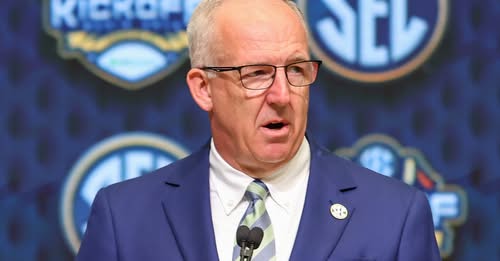In the ever-evolving landscape of college football, particularly in the high-stakes realm of postseason competition and playoff structures, communication between the top conferences and the sport’s leading administrative figures is paramount. When the College Football Playoff (CFP) expansion and its implications dominate the headlines, any perceived fissure among the Power Five commissioners can send shockwaves through the ecosystem. That’s why recent comments from SEC Commissioner Greg Sankey have drawn such significant attention—not just for what was said, but for what it indicates about the fragile balance of cooperation and competition at the top of the sport.
Sankey, who has served as the Commissioner of the Southeastern Conference since 2015, made clear during a recent interview that there is no “rift” between him and the Big Ten Conference or its leadership. This denial comes in response to swirling rumors and media narratives suggesting that the two most powerful conferences in college athletics were locked in an escalating dispute over the direction of the CFP and, by extension, the future of college football itself. With realignment, NIL (Name, Image, and Likeness), and athlete compensation already shaking the foundations of collegiate sports, the last thing fans, players, or administrators need is a public power struggle among the sport’s elite decision-makers.
The context for this controversy lies in the ongoing debates surrounding the structure of the expanded College Football Playoff, which is set to grow from four to twelve teams. This expansion, originally proposed to improve access and fairness, has become a hotbed of contention. The original model was crafted with a 6+6 format—six automatic bids for conference champions and six at-large bids. However, with the impending collapse or downgrade of the Pac-12 and the general weakening of the Group of Five’s power position, the format’s equity and practicality were called into question. What followed was a heated negotiation over how those twelve spots would be allocated moving forward.
The Big Ten, under new Commissioner Tony Petitti, expressed concern over maintaining sufficient access for their highly competitive programs, especially in light of their growing size and strength due to expansion. With USC, UCLA, Oregon, and Washington joining an already dominant conference, the Big Ten’s footprint has never been larger or more potent. The SEC, meanwhile, is likewise expanding with Texas and Oklahoma joining in 2024. Both conferences arguably boast the strongest collective resumes in college football and thus hold the greatest sway in shaping the playoff to match their interests.
However, reports indicated that there were disagreements about the new format—specifically whether the Power Four champions should all receive automatic bids, whether the Group of Five still deserved guaranteed representation, and how many at-large spots should be preserved for powerhouse programs. Some outlets painted these negotiations as a battle between the SEC and Big Ten, framing Sankey and Petitti as rivals unwilling to compromise. But Sankey was quick to push back against that characterization.
He explained that while the SEC is firm in its stance and fiercely protective of its own interests—especially given the conference’s unparalleled recent success in the CFP—it is not operating in bad faith or opposition to any other league. In fact, he stated that he speaks with Petitti regularly and that their relationship is “productive” and “respectful.” Sankey emphasized that they both understand the importance of collaboration, not just for their own conferences but for the broader health of college football. He insisted that mutual respect, not animosity, has governed their discussions.
Part of the misperception stems from the reality that the SEC and Big Ten now dominate the sport in ways previously unimaginable. Their collective media rights deals dwarf those of the other conferences. Their teams draw massive television audiences, produce the bulk of NFL Draft talent, and capture the lion’s share of playoff appearances and national titles. In many ways, they are college football’s professional leagues within the collegiate model. As a result, any sign of conflict between them is magnified and interpreted as a sign of deeper fractures in the sport’s foundation.
But according to Sankey, what’s really happening is a natural process of negotiation, driven by changing realities and evolving priorities. He acknowledged that the transition from a four-team to a twelve-team playoff was always going to involve friction. When the initial expansion discussions began, the landscape was different. Since then, conference realignment has accelerated at a breakneck pace. The Pac-12 is a shell of its former self. The Big 12 has reshaped its identity entirely. The Group of Five’s ability to compete at the highest level has come under increased scrutiny. Amid all these changes, what seemed like a fair and equitable playoff model three years ago may no longer serve its intended purpose.
That’s why Sankey believes that honest, sometimes difficult conversations are necessary. But he warns against interpreting these talks as a feud or a breakdown in communication. In his view, disagreements are a sign of engagement, not hostility. He further clarified that the SEC has no intention of dominating or dictating terms to the rest of the sport. Rather, it wants a system that reflects on-the-field results, prioritizes excellence, and ensures that deserving teams have a path to the postseason regardless of their conference affiliation.
Sankey also pushed back on the idea that the SEC and Big Ten are coordinating as a block to exclude the other conferences. While their size and influence may create overlapping interests, he insists that both leagues are independently advocating for what they believe is best. At times, that might mean alignment; at others, divergence. But he maintains that there is no conspiracy, no secret alliance, and certainly no plan to marginalize the ACC, Big 12, or the remaining Group of Five conferences.
The commissioner was also candid about the broader forces reshaping college sports. He acknowledged that the introduction of NIL and the legal push for athlete employment rights have transformed the NCAA model. As student-athletes gain more power and voice, the old assumptions about amateurism and competitive balance must be reexamined. This shift, he argues, requires strong leadership and thoughtful policymaking—not just in the SEC or Big Ten, but across the collegiate landscape.
He also stressed the importance of fan trust. Sankey understands that for many fans, college football is more than just a sport—it’s a cultural institution, a shared experience that connects generations. When the sport is perceived as being driven purely by money or backroom deals among commissioners, it erodes that trust. That’s why he believes transparency and unity are crucial. Even if there are internal disagreements, the public must see a commitment to fairness and integrity.
Moreover, Sankey warned against what he called “short-termism”—the tendency to make decisions based on immediate gain rather than long-term sustainability. He argued that the CFP’s success depends on creating a system that can endure for decades, not just satisfy today’s demands. That means considering the needs of players, coaches, fans, and institutions in a holistic way. It also means resisting the temptation to treat playoff access as a zero-sum game.
For Sankey, the ideal playoff is one that balances opportunity with excellence. He supports a model that rewards conference champions, but not at the expense of truly elite teams who may not win their league but still prove their mettle on the field. He also believes the playoff should be a reflection of the regular season—not a distortion of it. If the system rewards mediocrity or punishes excellence, it undermines the sport’s competitive ethos.
Interestingly, Sankey’s comments also included reflections on his personal rapport with Tony Petitti. He spoke of Petitti’s intelligence, media savvy, and dedication to improving the Big Ten. He rejected the notion that their differing perspectives have damaged their relationship, and instead described a dynamic built on mutual challenge and shared responsibility. Their job, as Sankey sees it, is to disagree when necessary, but always with an eye toward resolution and progress.
In the end, Sankey’s message was one of reassurance. He wants the public to understand that the process of shaping the CFP—and indeed the future of college football—is messy but not broken. It is driven by passionate, informed leaders who may not always agree but who share a common goal: preserving the greatness of the game. There may be bumps along the way, and yes, there will be headlines that exaggerate tensions. But the underlying foundation, he insists, remains solid.
This moment in college football history is without precedent. The changes happening now—conference realignment, playoff expansion, NIL empowerment, potential employment rights for athletes—are reshaping the sport more dramatically than any era since integration. In such a time of flux, disagreement is inevitable. What matters most is how those disagreements are handled. Sankey wants fans to know that, contrary to popular belief, he and his Big Ten counterpart are not at war. They’re at the table, talking, pushing, advocating, and above all else, trying to do what’s right for the sport they both care deeply about.
As college football moves toward a 12-team playoff, the decisions made in the next few months will ripple for years to come. The commissioners of the SEC, Big Ten, ACC, Big 12, and the rest must find common ground, even as they represent vastly different interests. Greg Sankey’s rejection of the “rift” narrative is a reminder that leadership often means finding unity amidst diversity. Whether the playoff ultimately includes automatic bids, favors the highest-ranked teams, or creates new incentives for scheduling and competition, it will be shaped by people willing to argue constructively, not destructively.
At its best, college football is a national celebration. Saturdays in the fall bind communities, inspire passion, and fuel dreams. Keeping that spirit alive in an era of seismic change requires wisdom, patience, and honest communication. Greg Sankey’s public remarks—denying a feud with the Big Ten—may not settle every controversy. But they serve as an important reminder that disagreement doesn’t have to mean dysfunction, and that the future of the sport still rests in the hands of those willing to lead with purpose.



